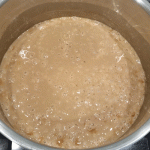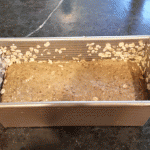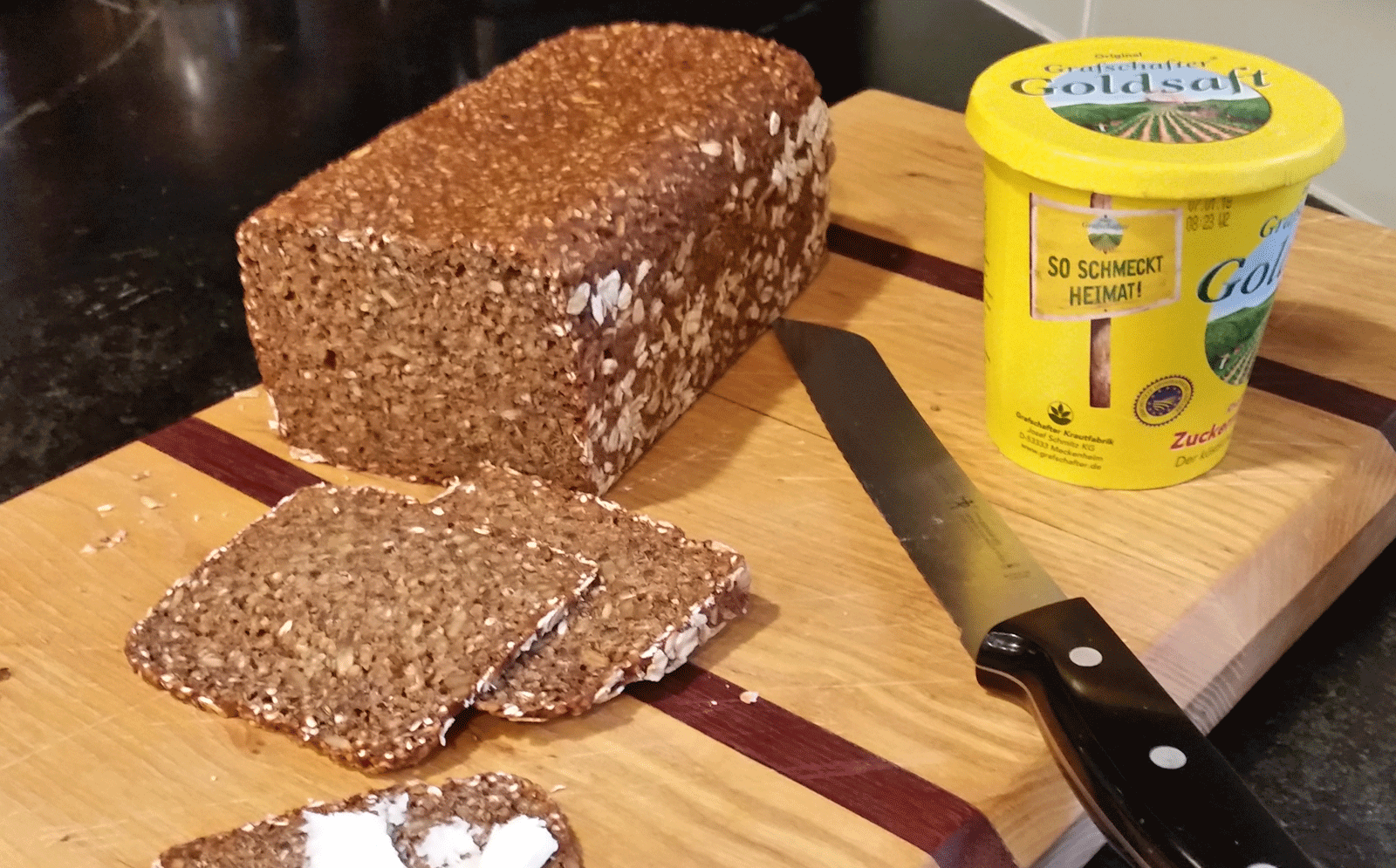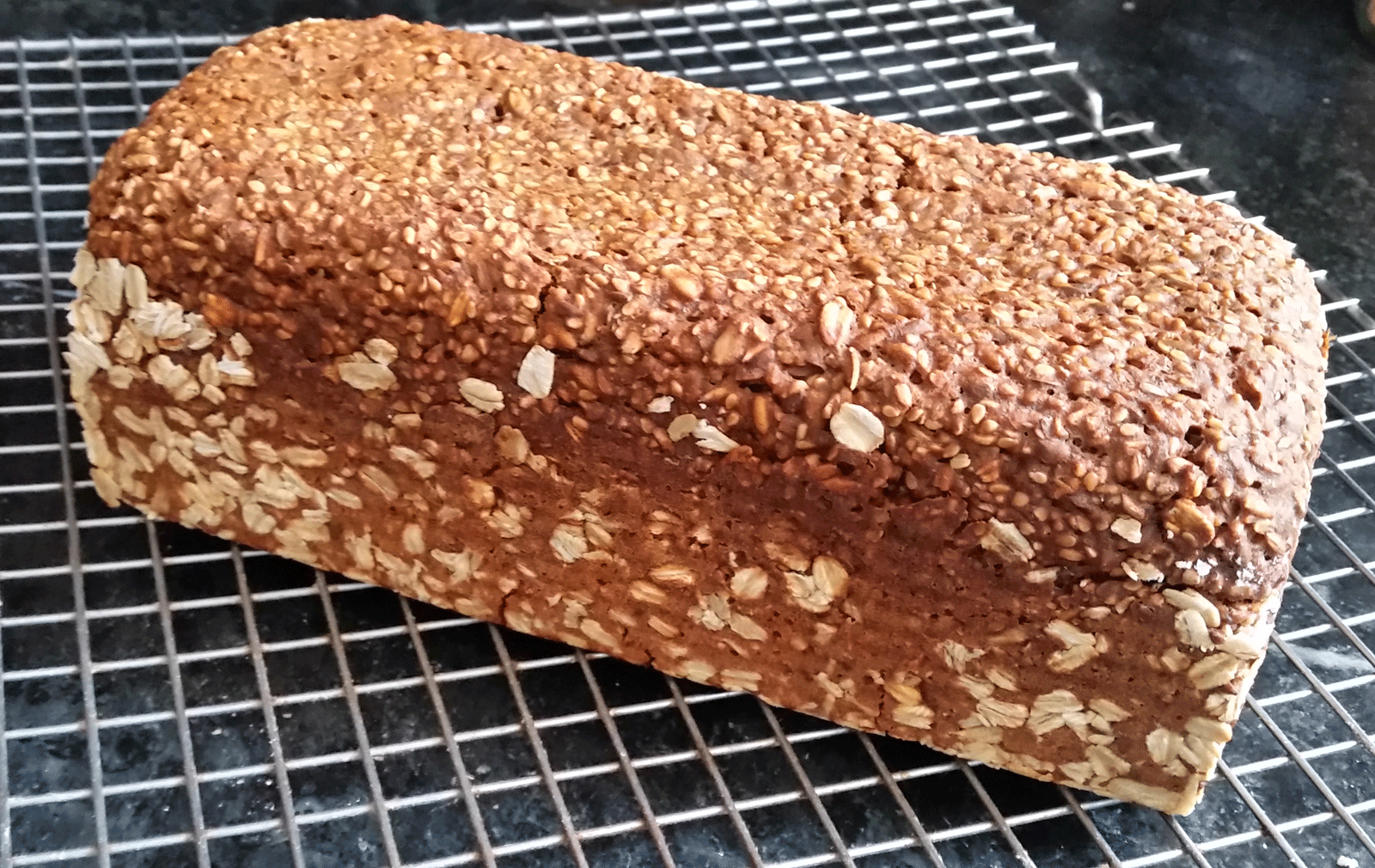| Rye %: | 74% |
| Stages: | Straight dough |
| Leaven: | Yeast |
| Start to Finish: | 3½-4 hours |
| Hands-on Time: | 20-25 minutes |
| Yield: | Two 2¾ lb./1.250 kg loaves |
Of all the different kinds of rye breads I’ve made and tasted, the coarse dark ones have always been among my favorites for their rustic mouthfeel and intense rye flavors. This buttermilk rye, which comes from northern Germany, has the added attraction of very short prep time, meaning that I can start a loaf at breakfast and have it for dinner.
Unlike most of the coarse breads I’ve made, this one is built on a yeast-leavened straight dough, acidified and hydrated with nearly 100% buttermilk – enough to tenderize the loaf’s coarse rye meal and cracked wheat during its 3-hour, moderate temperature bake. The texture gets added complexity from large additions of sunflower, flax and sesame seeds, while a generous addition of sugarbeet molasses (Rübenkraut or Zuckerrübensirop in German) combines with the buttermilk to produce a sof-edged sweet-sour combination that reminds me of vanilla-flavored yogurt.
This is a bread that goes well with almost anything; we had it instead of bagels for our Sunday cream cheese and smoked salmon brunch and it was magnificent.
| Ingredient |
Grams |
Ounces |
Baker’s |
| Buttermilk |
1,035 |
36.50 |
97.64% |
| Sugarbeet molasses or dark corn syrup |
250 |
8.80 |
23.58% |
| Instant yeast |
11 |
0.40 |
1.04% |
| Medium rye flour |
500 |
17.65 |
47.17% |
| Coarse rye meal |
280 |
9.90 |
26.42% |
| Cracked wheat |
280 |
9.90 |
26.42% |
| Salt |
18 |
0.65 |
1.70% |
| Flaxseed |
140 |
4.95 |
13.21% |
| Sesame seeds |
140 |
4.95 |
13.21% |
| Sunflower seeds |
100 |
3.55 |
9.43% |
| TOTAL FORMULA |
2,754 |
97.15 |
259.81% |
| TOTAL FLOUR |
1,060 |
37.40 |
100.00% |
| Vegetable shortening for pan |
As needed |
||
| Rolled oats for dusting |
As needed |
||

Combine the buttermilk and sugarbeet molasses in a saucepan and warm to body temperature (100°F/38°C). Add the yeast, stir to dissolve and let stand until bubbly, 10-15 minutes.
In the mixer, combine the buttermilk mixture, rye flour, rye meal, cracked wheat and salt and use the paddle at low (KA2) speed to mix until it has the consistency of a thick cake batter, 8-10 minutes. Add the seeds and mix to blend, 2-3 minutes.
 Use a plastic dough scraper and wet hands to transfer the dough into two well-greased 9″x4″x4″/23x10x10 cm. Pullman loaf pans or two 9″x5″x3″/23x13x8 cm standard loaf pans that have been dusted with rolled oats. Cover and let stand at room temperature (70°F/21°C) until the dough rises to within ¾”/1.80 cm of the rim, 15-20 minutes.
Use a plastic dough scraper and wet hands to transfer the dough into two well-greased 9″x4″x4″/23x10x10 cm. Pullman loaf pans or two 9″x5″x3″/23x13x8 cm standard loaf pans that have been dusted with rolled oats. Cover and let stand at room temperature (70°F/21°C) until the dough rises to within ¾”/1.80 cm of the rim, 15-20 minutes.
Preheat the oven to 285°F/140°C with the baking surface in the upper half. Bake until the internal temperature is at least 198°F/92°C, 3-3½ hours. Remove from the pan and transfer to a rack until thoroughly cool. Best after resting at least 24 hours. Slice thin.




Trevor J. Wilson
March 27, 2016I just found your blog from your post of TFL. It’s great to see such a variety of rye breads being explored here. I love a good hearty rye and these all look good. I’ll be checking back here often.
Cheers!
Trevor
Heike
March 28, 2016Hi Stanley,
I like “Schwarzbrot” very much.
I´m baking it in Weck jars.
Will there soon be a “Look Inside” for your new book at amazon?
Sincerely
Heike
Stanley Ginsberg
March 28, 2016I believe there will be a look inside, but that’s the publisher’s decision.
Kirsten
April 16, 2016Hi Stanley,
Thanks for this recipe. I grew up in North Gemany and was excited to find a recipe that lets you make Schwarzbrot in just a few hours. All my other recipes use rye sour and take a couple of days. I like the crumb and the chewiness of the whole grain. My only issue with it is the amount of sweetener. I followed the recipe even though I was skeptical and it turned out much too sweet for me. I have honestly never eaten such a sweet Roggenbrot. I’d be curious to know where you found the recipe. I will definitely bake the bread again but with maybe just 25-50 grams of the Sirup. That’s how much I use in my other rye-recipes. Zuckerrübensirup is a highly valued commodity in our household because I have to bring it home from my trips to Germany. So that’s good 🙂
Stanley Ginsberg
April 16, 2016I don’t remember where I found this recipe, probably a German bread blog or one of my many German baking books; however, it uses the same percentage of Zuckerrübensirop to flour as Bernd Armbrust’s Einfaches Vollkornbrot from his book “Brot.” His bakery, Bäckerei Blankenhaus, is in Bochum (Nordrhein-Westfälen in NW Germany, for those unfamiliar with German geography).
Incidentally, it’s possible to buy Zuckerrübensirop online, both from US suppliers and also via amazon.de. I buy mine from a German market in my area.
Corina Gaffney
June 4, 2016Where do you get your coarse rye meal?
Stanley Ginsberg
June 4, 2016We sell it at http://www.nybakers.com
Sabine Friedrich-Walter
December 17, 2016Hi All, Hi Stanley
I am just browsing through your monthly post’s and came across with the buttermilk rye whole grain bread… I bake this kind of bread for years as a quick bread and the recipe is very similar , except I only use 150 g Ruebensirup or Date Molasses. Not as sweet as the recipe you posted.
Thanks for all these good recipes. I keep baking every week .
Sabine
MaryJo
June 13, 2016I’m visiting my daughter, and though I brought most of the ingredients with me, I had to adapt the recipe. Her KitchenAid is a 30 year old K45, so I beat the dough by hand; I couldn’t find buttermilk so I used SACO buttermilk powder and water; she only has glass bread pans and no oven thermometer so I set the oven at 250°F and the timer at 2.5 hours. I should have checked sooner because the bread tested over 200°F and is darker than it should be–I suspect that it was done a lot closer to 2 hours. I have no idea if her oven is even close to correct…
So I’ve got the loaves wrapped in a tea towel and I’m hoping for the best when we slice it tomorrow.
Stanley Ginsberg
June 13, 2016glass pans are very tricky b/c they retain heat much longer than metal pans, creating thick crusts. Also, it may be that your daughter’s oven is hotter than the setting indicates. Inaccurate temperature settings are unfortunately all too common. The only way to be sure of the oven is to create a heat map by placing a pair of oven thermometers in various places around the oven, making sure to switch places on the first go-round in order to determine whether the thermometers themselves are in sync.
Let us know how they turn out!
MaryJo
June 14, 2016It turns out that my daughter thought that I knew the oven runs hot by at least 25°F, so she didn’t mention it. (sigh) The problems of baking in someone else’s kitchen with the equipment available.
As I mentioned, I wrapped the loaves in a tea towel hoping that would help to soften the crust a bit (a technique I use for Irish brown bread), and after they were completely cooled, I wrapped the loaves tightly in cling wrap and let them sit until this morning. The crust is really hard and thick, but the very center is pretty good. The flavor is milder than I expected, but the texture is great. Definitely a recipe that I will revisit after I get to my favorite local restaurant supply for proper pans and a couple of oven thermometers.
I’m curious about the beet sugar molasses that you mention, Stanley. How is it different from cane sugar molasses?
Stanley Ginsberg
June 14, 2016Beet molasses (Rübenkraut or Zuckerrübensirop in German) is basically the same as sugar cane molasses — that is, what remains after the white sugar is extracted from the juice. However, it’s far less smoky, lighter-tasting and less acidic (to my taste, anyway) than cane molasses, which I find is much more present, taste-wise in breads that use it.
Joyce
July 5, 2016Can this be made with a sourdough starter? If so how much would I use?
Stanley Ginsberg
July 5, 2016I wouldn’t, only because switching to a wild yeast starter would complicate things considerably and change the taste. If you want to use a sourdough sponge, substitute water or plain milk for the buttermilk, eliminate the yeast and preferment a sponge using 400g of the rye flour and about 40g of starter. But then, you’d have a very different bread from this one.
Joyce
July 5, 2016Thanks. Will try as written
louise
July 21, 2016i am very excited to give this recipe a try. do you suggest baking with the pullman lid on or off? and what are your thoughts on presoaking the seeds and cracked wheat? thanks so much for this blog!
Stanley Ginsberg
July 21, 2016I generally bake with the lid off, and since the bake (steaming, really) takes at least 3 hours, the seeds hydrate nicely without the need to soak.
And you’re welcome!!
Boris
January 22, 2017Would there be anything wrong with using soaked whole rye berries instead of wheat there? I like their taste and chewiness better and also would rather have them than seeds in the bread.
Stanley Ginsberg
January 22, 2017Not at all. Experiment away!
Sue Shields
February 5, 2017I tried this one this weekend because I had exactly the right amount of buttermilk in the refrigerator left over from another recipe. I used dark Karo syrup as the sweetener. Definitely not over-sweet, just nicely-balanced. I did have to wait well over an hour for it to rise up to 3/4 inch from the top of the Pullman pans. The buttermilk-yeast-syrup mixture was plenty foamy and energetic, but it still took awhile. The three hour bake smelled heavenly and the final product was terrific!
Tsuft
February 9, 2018Hi
Can I subtitute the yeast with rye sourdough?
Stanley Ginsberg
February 11, 2018of course! you just need to let the dough ferment longer to make up for the relative weakness of the wild yeast.
Kristi
December 19, 2020Question below — I have made this twice with freshly milled rye (once ‘as written’, and once with buttermilk & kefir -for more sour- with the addition of grated apples…adjusting up the amount of flour & meal to account for the extra moisture from the freshly grated apples…also subbing in boiled cider syrup for molasses/syrup). I was pleased with both – but imo, both would have benefited from a long/slow ‘pumpernickel bake’. My question – do you have a suggestion for loading/baking temp & time for a slow-low pumpernickel type bake? Thank you in advance – and for the recipe, and for your book (from which I’m learning so much).
Stanley Ginsberg
January 17, 2021My best suggestion is to take a look at the slow-bakes in the book (Frisian rye, Boston Brown Bread, Jalkiunileipaa) and interpolate.